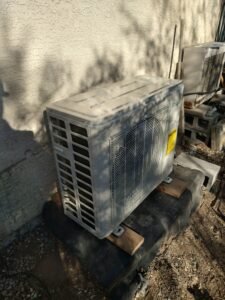In this article, we explore the capabilities of ductless mini-split systems in providing simultaneous heating and cooling to different zones within a house. Mini split heating and cooling systems have gained popularity due to their versatility and efficiency, as they can be installed in various settings, including residential homes, garages, work sheds, and even large warehouse spaces. However, the question arises: can these systems effectively cater to the heating and cooling needs of different house zones simultaneously? Let’s delve into this topic to gain a better understanding of the functionality and potential of ductless mini-split systems.

Understanding Ductless Mini-split Systems
What is a ductless mini-split system?
A ductless mini-split system is a type of heating and cooling system that does not require ductwork to distribute air throughout a building. It consists of an outdoor unit and one or more indoor units, which are connected by refrigerant lines. Each indoor unit is responsible for heating or cooling a specific zone or room in the house. This system is called “ductless” because it eliminates the need for traditional ductwork, making it an ideal solution for buildings without existing duct systems or where duct installation is not feasible.
How does a ductless mini-split system work?
Ductless mini-split systems work by utilizing the principles of refrigeration. The outdoor unit contains a compressor and condenser, while the indoor units contain an evaporator and fan. When the system is in cooling mode, the compressor and condenser in the outdoor unit work together to remove heat from the indoor air, expelling it outside. The evaporator in each indoor unit absorbs the heat from the room air, which is then circulated back as cool air. In heating mode, the process is reversed, with the outdoor unit extracting heat from the outside air and transferring it indoors.
Benefits of Ductless Mini-split Systems
Energy efficiency
One of the major benefits of ductless mini-split systems is their energy efficiency. Since they do not require ductwork, there are no energy losses associated with leaky ducts or the need to cool or heat unused areas. Each indoor unit can be independently controlled, allowing for greater energy savings by only heating or cooling occupied spaces. Additionally, ductless mini-split systems often have higher energy efficiency ratings, such as SEER (Seasonal Energy Efficiency Ratio) for cooling and HSPF (Heating Seasonal Performance Factor) for heating, compared to traditional HVAC systems.
Zoning capabilities
Another advantage of ductless mini-split systems is their zoning capabilities. With individual indoor units for each zone or room, it is possible to create different temperature settings and levels of comfort throughout the house. This is especially beneficial in households where different individuals prefer different temperature settings or when there are areas that need heating or cooling more frequently than others. Zoning allows for personalized comfort and eliminates the need to heat or cool the entire house when it is not necessary, leading to additional energy savings.
Heating and Cooling with Mini-split Systems
Simultaneous heating and cooling
Mini-split systems have the unique ability to provide both heating and cooling simultaneously. This is particularly useful during transitional seasons where there may be a need for heating in the morning and cooling in the afternoon. With a ductless mini-split system, you can have the flexibility to heat one zone while cooling another, ensuring personalized comfort throughout the day.
Different house zones
Ductless mini-split systems are designed to provide heating and cooling in different zones of a house. This is especially valuable in multi-story homes or houses with distinct areas that require different temperature control. By dividing the house into zones, you can maintain optimal comfort levels in each area without wasting energy by heating or cooling the entire house when it is not necessary.
Simultaneous Heating and Cooling
The concept of simultaneous heating and cooling
Simultaneous heating and cooling refers to the ability of a ductless mini-split system to provide both heating and cooling functions at the same time. While traditionally, HVAC systems would only be able to perform either heating or cooling operations, mini-split systems have advanced technology that allows for simultaneous functionality.
How is simultaneous heating and cooling achieved?
Simultaneous heating and cooling in a mini-split system is achieved through a process called heat recovery. In a standard system, the refrigerant flow is either directed to the indoor units for cooling or to the outdoor unit for heating. However, in a system with heat recovery capabilities, the refrigerant flow can be modified to allow for both operations simultaneously. By diverting the refrigerant flow, the system can extract heat from one zone and transfer it to another, enabling cooling in one zone while providing heating in another.

Different House Zones
Understanding house zoning
House zoning refers to the division of a building into different areas or zones, each with its own heating and cooling requirements. This can be done for various reasons, including individual preferences for temperature, different usage patterns of the rooms, or the need to conserve energy. Zoning allows for better control and customization of the indoor environment, promoting comfort and energy efficiency.
How does a mini-split system provide heating and cooling in different zones?
Ductless mini-split systems are well-suited for providing heating and cooling in different zones of a house due to their individual indoor units. Each indoor unit can be installed in a specific room or area and can be independently controlled. This means that you can set different temperature settings for each zone, allowing for optimal comfort and temperature control. By heating or cooling specific zones only when needed, you can save energy and reduce utility costs.
Installation Considerations for Different Zones
Evaluating the number of indoor units
When installing a ductless mini-split system for different zones, it is essential to evaluate the number of indoor units required. The number of units will depend on the size of each zone and the specific heating and cooling needs. Additionally, it is essential to consider the layout of the house and the placement of indoor units to ensure even distribution of air and efficient operation.
Choosing the right capacity
Choosing the right capacity for each indoor unit is crucial to ensure effective heating and cooling in different zones. The capacity is determined by factors such as the size of the area, insulation, and the desired temperature range. Oversized or undersized units can result in inefficient operation and discomfort. Consulting with a professional HVAC technician can help determine the optimal capacity for each zone.
Optimal positioning for multi-zone functionality
To achieve multi-zone functionality and simultaneous heating and cooling, the positioning of indoor units is crucial. The indoor units should be strategically placed in areas where they can effectively distribute air throughout the zone. It is important to avoid obstructing the airflows or placing units too close together, as this can disrupt the airflow and limit the system’s performance.

Benefits of Simultaneous Heating and Cooling in Different Zones
Personalized comfort
The ability to simultaneously heat and cool different zones in a house provides personalized comfort to each occupant. Each person can have their preferred temperature setting in their specific zone, allowing for optimal comfort and satisfaction.
Energy savings
Simultaneous heating and cooling in different zones offer significant energy savings. By only conditioning the zones that require heating or cooling at a given time, energy is not wasted on unoccupied or less frequently used areas. This targeted approach minimizes energy consumption and reduces utility costs.
Improved indoor air quality
Ductless mini-split systems contribute to improved indoor air quality in different zones. Each indoor unit has its own air filter, which helps trap dust, allergens, and pollutants. By having separate filters for each zone, the system can effectively remove impurities from the air, promoting healthier indoor environments.
Potential Limitations
Cost considerations
While ductless mini-split systems offer numerous benefits, they can be more expensive upfront compared to traditional HVAC systems. The cost includes the price of the units, installation, and additional components. However, it is important to consider the long-term energy savings and increased efficiency that can offset the initial investment.
Impact on overall system efficiency
Simultaneous heating and cooling in different zones can slightly impact the overall efficiency of the mini-split system. The system must divert some of its capacity to accommodate simultaneous operations, which may affect the cooling or heating capacity in each zone. However, with proper sizing and system design, any impact on efficiency can be minimized, and the benefits of zoning and simultaneous heating and cooling outweigh this potential limitation.

Maintenance and Troubleshooting
Regular maintenance for optimal performance
To ensure optimal performance of ductless mini-split systems, regular maintenance is essential. This includes cleaning or replacing air filters, inspecting and cleaning the indoor and outdoor units, checking refrigerant levels, and ensuring proper airflow. Regular maintenance can help prevent system malfunctions, increase energy efficiency, and prolong the lifespan of the system.
Identifying and resolving common issues
If a problem arises with a ductless mini-split system, it is important to identify and resolve the issue promptly. Common issues may include refrigerant leaks, airflow obstructions, thermostat malfunctions, or compressor problems. Consulting with a professional HVAC technician can help diagnose and resolve any issues and ensure the system operates at its best.
Conclusion
Ductless mini-split systems offer a comprehensive solution for heating and cooling in different zones. Their energy efficiency, zoning capabilities, and ability to provide simultaneous heating and cooling make them an ideal choice for various applications. Despite potential limitations and maintenance requirements, the benefits of personalized comfort, energy savings, and improved indoor air quality make ductless mini-split systems a valuable investment for homeowners looking for efficient heating and cooling solutions.


